Ushabti: Servants Who Worked For Their Owners In Afterlife In Ancient Egyptian Beliefs
A. Sutherland - AncientPages.com - Ushabti were servants devoted to working for their deceased owners. In ancient Egyptian religion, the tombs were equipped with small-sized and mummy-shaped figurines with arms crossed on the chest. The use of them was widespread, and their 'mission' was to set the deceased free from the necessity of labor in the afterlife.
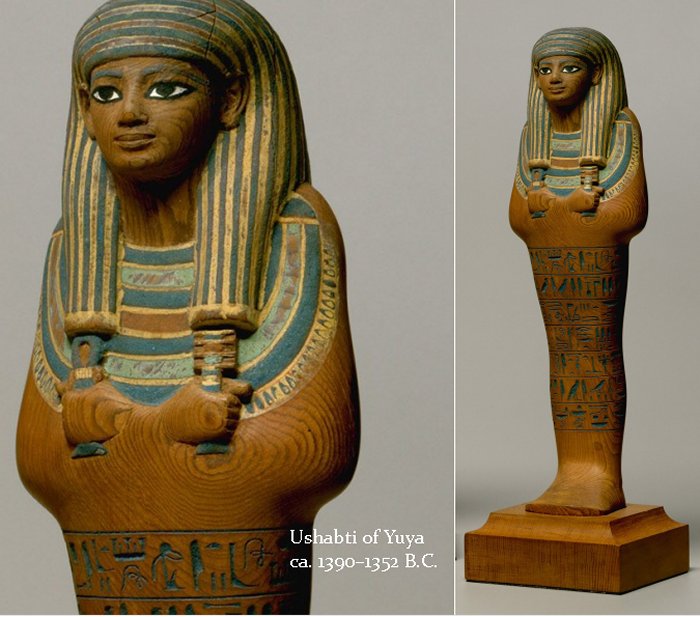 Shabti of Yuya. As the parents of Queen Tiye, wife of Amenhotep III, Yuya and Tjuyu were granted burial in the Valley of the Kings. They were provided with funerary equipment from the finest royal workshops, as demonstrated by this wonderfully carved shabti, on which even the knees are indicated in detail. The text on the figurine states that the shabti will substitute for the spirit in any necessary and obligatory tasks it is called upon to perform in the afterlife. (New Kingdom: the 18th Dynasty, reign of Amenhotep III. Date: ca. 1390–1352 BC. image source
Shabti of Yuya. As the parents of Queen Tiye, wife of Amenhotep III, Yuya and Tjuyu were granted burial in the Valley of the Kings. They were provided with funerary equipment from the finest royal workshops, as demonstrated by this wonderfully carved shabti, on which even the knees are indicated in detail. The text on the figurine states that the shabti will substitute for the spirit in any necessary and obligatory tasks it is called upon to perform in the afterlife. (New Kingdom: the 18th Dynasty, reign of Amenhotep III. Date: ca. 1390–1352 BC. image source
Depending on the tomb, the number of ushabtis varied; some had beautiful form and rich, full of details decoration, especially when made of enamel, applied by ancient Egyptians to stone objects, pottery, and sometimes even jewelry.
Sometimes, early ushabtis were made of wax, but most often, clay and wood were used in their production. Later figurines were usually made of much more resistant and durable materials like stone, terracotta, metal, glass, and most frequently, glazed earthenware known as the Egyptian faience (blue-green glazed ushabtis).
While ushabtis manufactured for the rich were often miniature works of art, however, the significant quantities of discovered ushabti figurines were the result of cheap artistry, based on single molds with a few details, only. Archaeologists frequently discovered boxes full of ill-shaped and uninscribed porcelain figures buried in the tombs with the dead.
These small workers were stored, but always ready to answer the call of the gods to work in the next world for the owner of the tomb.
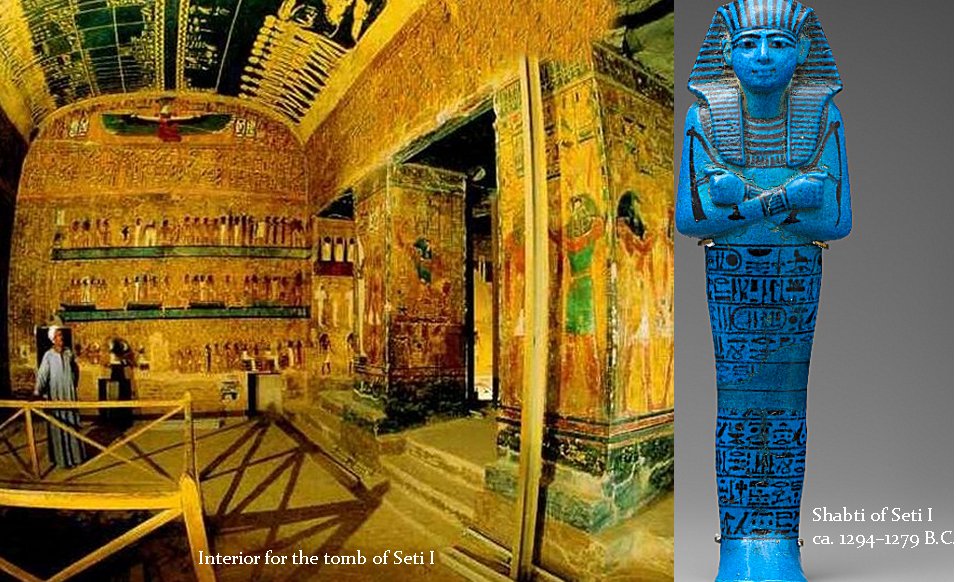 This ushabti was one of the hundreds made for the pharaoh Seti I, the father of Ramesses II. Shabtis were placed in a tomb so the owner's spirit would not have to perform manual labor in the afterlife.
This ushabti was one of the hundreds made for the pharaoh Seti I, the father of Ramesses II. Shabtis were placed in a tomb so the owner's spirit would not have to perform manual labor in the afterlife.
The use of the ushabti figures continued down to the Roman period and the tradition was widespread. Over the centuries, the number and quality of these artifacts changed. In the early Middle Kingdom, it was common to place two pieces of carefully made figurines in the grave. Later, in the Late period, ancient Egyptians decided that the deceased needed many more workers who accompanied them to the afterlife, and it was not uncommon to put up to one thousand of these artifacts in a tomb.
During the 18th Dynasty of Thutmose IV, they began to be fashioned as servants with sacks, baskets, and agriculture tools. With such equipment, the ushabti-workers could magically replace the dead owner when the gods requested him to undertake physical work such as irrigation and cultivation of fields, clearing irrigation channels, etc.
Even royal ushabtis were often depicted holding a hoe or a pick and carrying a basket on shoulders.
The ushabtis were usually covered with texts, and included in grave equipment from the Middle Kingdom (21st-18th centuries BC) to the Ptolemaic period (332–30 BC). During the New Kingdom (1539–1075 BC), the figurines were made to resemble the tomb's owner, and were fashioned in the form of a mummy, bearing the owner’s name.
It is said that in the tomb of Seti I, king of Egypt about 1370 BC no less than seven hundred wooden ushabtis were found inscribed with the 6th Chapter of the Book of the Dead, and covered with bitumen, which was used by ancient Egyptians to embalm mummies.
Written by – A. Sutherland - AncientPages.com Senior Staff Writer
Copyright © AncientPages.com All rights reserved. This material may not be published, broadcast, rewritten or redistributed in whole or part without the express written permission of AncientPages.com
Expand for referencesReferences:
Brier B, Hobbs H., Daily Life of The Ancient Egyptians
A. Wallis Budge, Egyptian Magic
More From Ancient Pages
-
 Evolution Of Paleodiet At Neolithic Qujialing Site Unveiled By Scientists
Archaeology | Nov 30, 2022
Evolution Of Paleodiet At Neolithic Qujialing Site Unveiled By Scientists
Archaeology | Nov 30, 2022 -
 Young Girl Finds Rare Ancient Megalodon Shark Tooth On Maryland Beach
Archaeology | Jan 16, 2023
Young Girl Finds Rare Ancient Megalodon Shark Tooth On Maryland Beach
Archaeology | Jan 16, 2023 -
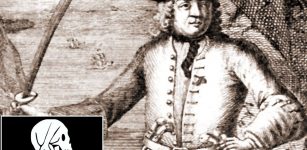 Jolly Roger – Symbol Of Golden Age Piracy
Ancient History Facts | Jan 22, 2017
Jolly Roger – Symbol Of Golden Age Piracy
Ancient History Facts | Jan 22, 2017 -
 Unexplained Historical Mass Disappearances – Where Did They Go? – Part 2
Featured Stories | Jun 4, 2019
Unexplained Historical Mass Disappearances – Where Did They Go? – Part 2
Featured Stories | Jun 4, 2019 -
 On This Day In History: First Battle Of Reading Took Place – On Jan 4, 871 AD
News | Jan 4, 2017
On This Day In History: First Battle Of Reading Took Place – On Jan 4, 871 AD
News | Jan 4, 2017 -
 Medieval Music Wasn’t Only Supposed To Be Beautiful To Listen To – A New Study Suggests
Archaeology | Jun 8, 2023
Medieval Music Wasn’t Only Supposed To Be Beautiful To Listen To – A New Study Suggests
Archaeology | Jun 8, 2023 -
 New Giant Geoglyph Of Orca With Mysterious Symbols And A ‘Trophy Head’ Found In Nazca Lines
Archaeology | Nov 18, 2017
New Giant Geoglyph Of Orca With Mysterious Symbols And A ‘Trophy Head’ Found In Nazca Lines
Archaeology | Nov 18, 2017 -
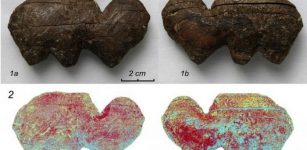 Ancient Mammoth Ivory Carving Technology Of Master Craftsmen – Reconstructed
Archaeology | Aug 27, 2020
Ancient Mammoth Ivory Carving Technology Of Master Craftsmen – Reconstructed
Archaeology | Aug 27, 2020 -
 Archaeologists Discover Ancient Mayan Board Game – Here’s What It Can Teach Modern Educators
Featured Stories | May 19, 2023
Archaeologists Discover Ancient Mayan Board Game – Here’s What It Can Teach Modern Educators
Featured Stories | May 19, 2023 -
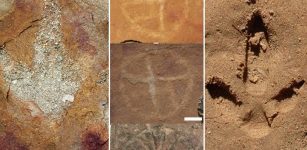 Intriguing Collection Of Petroglyphs And Dinosaur Footprints Found At The Serrote do Letreiro Site, Brazil
Archaeology | Mar 20, 2024
Intriguing Collection Of Petroglyphs And Dinosaur Footprints Found At The Serrote do Letreiro Site, Brazil
Archaeology | Mar 20, 2024 -
 Mysterious Biblical Celestial City And Its Connection To The North Star – Nonhuman Hands – Part 1
Biblical Mysteries | Feb 22, 2021
Mysterious Biblical Celestial City And Its Connection To The North Star – Nonhuman Hands – Part 1
Biblical Mysteries | Feb 22, 2021 -
 Unexplained Encounters With A Mysterious Being In South Dakota Reported – Why Is This Happening?
Featured Stories | Jul 9, 2024
Unexplained Encounters With A Mysterious Being In South Dakota Reported – Why Is This Happening?
Featured Stories | Jul 9, 2024 -
 The Untold Story Of Mexico’s Ancient Giant Indians – Cunning Plan And The Evil Nation – Part 2
Featured Stories | Sep 23, 2019
The Untold Story Of Mexico’s Ancient Giant Indians – Cunning Plan And The Evil Nation – Part 2
Featured Stories | Sep 23, 2019 -
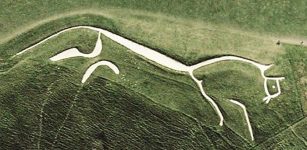 Mystery Of Prehistoric Gigantic Hill Figures Of England
Featured Stories | Sep 20, 2018
Mystery Of Prehistoric Gigantic Hill Figures Of England
Featured Stories | Sep 20, 2018 -
 Golden Secrets Of Lake Guatavita And The Muisca People Gave Rise To The El Dorado Myth
Featured Stories | Nov 12, 2019
Golden Secrets Of Lake Guatavita And The Muisca People Gave Rise To The El Dorado Myth
Featured Stories | Nov 12, 2019 -
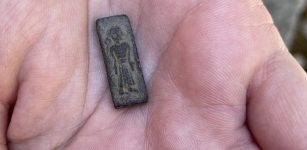 Rare And Tiny Ancient Stamps Found In Falster May Show The Way To An Unknown King’s Home
Archaeology | Jul 26, 2023
Rare And Tiny Ancient Stamps Found In Falster May Show The Way To An Unknown King’s Home
Archaeology | Jul 26, 2023 -
 Famous Benin Bronzes Were Made Of German Brass – Study Reveals
Archaeology | Apr 6, 2023
Famous Benin Bronzes Were Made Of German Brass – Study Reveals
Archaeology | Apr 6, 2023 -
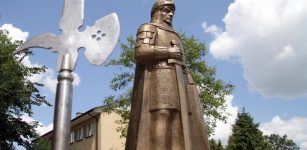 Zawisza Czarny: Most Famous Polish Knight And The Quest For His Family Home
Featured Stories | Apr 26, 2016
Zawisza Czarny: Most Famous Polish Knight And The Quest For His Family Home
Featured Stories | Apr 26, 2016 -
 Deciphered Ancient Cuneiform Tablets Reveal Locations Of Long-Lost Cities And Shed Light On The Secrets Of Mesopotamia
Places | Oct 20, 2024
Deciphered Ancient Cuneiform Tablets Reveal Locations Of Long-Lost Cities And Shed Light On The Secrets Of Mesopotamia
Places | Oct 20, 2024 -
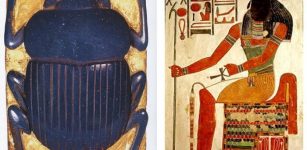 Khepri – Egyptian Progenitor God, Spirit Of Life, Resurrection And The Rising Sun
Egyptian Mythology | May 14, 2020
Khepri – Egyptian Progenitor God, Spirit Of Life, Resurrection And The Rising Sun
Egyptian Mythology | May 14, 2020
